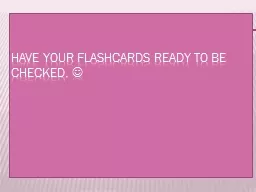

Los verbos reflexivos Objective To be able to talk about your daily routine Getting ready for a special event Reflexive verbs In this presentation we are going to look at a special group of verbs called ID: 830060
Download The PPT/PDF document "Have your flashcards ready to be checked..." is the property of its rightful owner. Permission is granted to download and print the materials on this web site for personal, non-commercial use only, and to display it on your personal computer provided you do not modify the materials and that you retain all copyright notices contained in the materials. By downloading content from our website, you accept the terms of this agreement.
Slide1
Have your flashcards ready to be checked.
Slide2Los
verbos reflexivos
Objective:
To be able to talk about your daily routine.
Getting ready for a special event.
Slide3Reflexive verbs
In this presentation, we are going to look at a special group of verbs called
reflexive verbs
Let’s start out by thinking of the English verb to wash.
lavo
lavamos
lavaslaváis
lavalavan
Slide4To wash the Car…
I can wash things that are
not part of me.
In Spanish, we say: Yo lavo el carro
.
The action of the verb goes to the car. Subject: I,
Verb: washObject: car
Slide5Now let’s take “
lavar” and add “se” to it. It becomes “LAVARSE” which is now reflexive. This “se” attached to the verb indicates that subject and the action are the same.
You can wash yourself or a part of your body: hands, face, hair…
I wash my hands. In Spanish: Me lavo las manos.
Subject: I, Verb: wash
Object: myself
Slide6The point is…
If you are washing something that is attached
to your body, you need to use
reflexive pronouns.
Slide7What are the reflexive pronouns?
me
noste
ossese
Slide8Let’s conjugate
Lavarseme
lavo
nos lavamoste lavas
os laváis
se lavase lavan
The endings are still the same. In this case these are endings for regular “ar” verbs in the present tense.
Slide9Afeitarse
& acostarseMe
afeitoNos
afeitamosTe afeitasOs
afeitáisSe
afeitaSe afeitan
Me acue
stoNos acostamosTe
ac
ue
stas
Os
acostáis
Se
acu
e
sta
Se
ac
ue
stan
Slide10Notice the placement of the reflexive pronouns in Spanish:
Sue bathes herself.
reflexive pronoun
subject
Sue
Sue se
baña
.
reflexive pronoun
subject
Slide11Notice the placement of the reflexive pronouns in Spanish:
Joe shaves himself.
reflexive pronoun
subject
Joe
Joe se afeita.
reflexive pronoun
subject
Slide12The reflexive pronoun
goes before the conjugated verb.
Slide13**When you have two verbs in a sentence. **
Non-Reflexive: You must conjugate the first verb and you keep the infinitive for the 2nd one.
For example: I need to wash the car: Necesito lavar el coche
.
Slide14Reflexive:
1. If we follow the placement rule from above (Sue se baña), you place the pronoun BEFORE CONJUGATED VERBS.
I need to wash my hair. Me necesito lavar el pelo. She
needs to put make up on. Se necesita maquillar.
Slide152. You can also ATTACH the reflexive pronoun to the infinitive.
I need to wash my hair. Necesito lavarme el pelo
. She needs to put make up on. Necesita maquillarse.
Slide16Keep in mind:
Just as you would NEVER write “Yo lavar el carro.” You CANNOT write “Yo lavarme el pelo”
How would you fix “Yo lavarme el pelo” based on the two rules? 1
. Necesito lavarme el pelo. 2. Me necesito lavar el pelo.Or if you use only one verb, 3.
Me lavo el pelo.
Slide17Remember….
Place the reflexive pronoun BEFORE the CONJUGATED verb ORATTACHED to the INFINITIVEWhen you have two verbs next to each other conjugate the first one only.
Slide18Dormir vs. Dormirse
The verb
forms are the
same: duermo, duermes, duerme, dormimos, duermenThe difference in form is
the addition of the
reflexive pronouns: me, te, se, nos, seThe difference in meaning
is:Dormir :
to sleepDormirse : to fall asleep
Slide19DORMIR
DORMIRSETO SLEEPTO FALL ASLEEPduermo
me duermodormimosnos
dormimosduermeste duermesdormísos dormísduerme
se duermeduermense duermen
Slide20A morning routine
Todos los días, yo ____1.____ (levantarse) a las 7:00. ___2.____(lavarse) la cara, y
_____3._____ (afeitarse). Luego ____4.____ (vestirse (e-i)) y ____5.____(comer) un poco de desayuno. Por fin, ____
6.____ (cepillarse) los dientes.
Slide21Respuestas
Todos los días yo 1.me levanto
a las 7:00. 2.Me lavo la cara y 4.me afeito. Luego
5.me visto y 6.como un poco de desayuno. Por fin, 7.me cepillo los dientes
Slide22A verb followed by a reflexive verb:
Remember that in a sentence when there are 2 verbs next to each other, you conjugate the first verb and leave the second verb in its infinitive form. EX: Yo necesito estudiar.
The rule is a little different when a verb is followed by a reflexive verb.Instead of placing the reflexive pronoun in front of the verb, you will leave it attached to the infinitve, BUT CHANGE IT to AGREE with the subject.
Slide23Some examples:
Yo necesito levantarme. Tú necesitas
despertarte. Nosotros queremos bañarnos
.